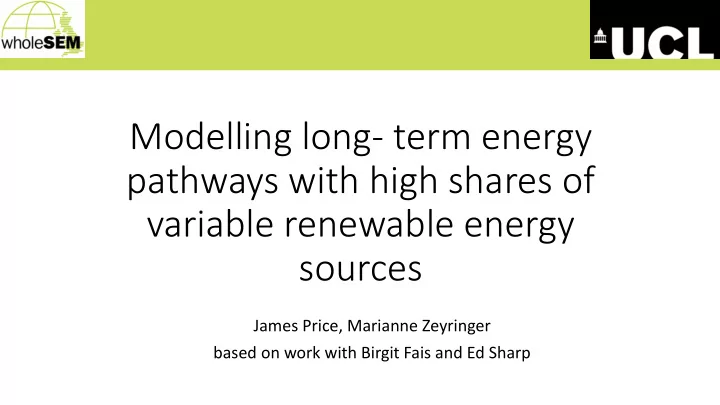

Modelling long- term energy pathways with high shares of variable renewable energy sources James Price, Marianne Zeyringer based on work with Birgit Fais and Ed Sharp
UKTM • The UK TIMES (UKTM) model is a linear optimization bottom-up technology-rich energy system model • Runs from 2010 to 2050 • 16 time slices: 4 seasons and 4 intraday (day, evening, late evening, night) • One region representing the whole of the UK • VRE represented as technologies with low availability factors with limited variability between time slices
Representation of variable renewable energy technologies (VRE) in UKTM VRE and demand vary in time and space Not sufficient spatial and temporal resolution to represent 1. Renewable generation 2. Demand 3. Flexible generation 4. Storage 5. Transmission extension + Their interaction Modeling of single weather years does not capture the full variability of weather conditions How well does UKTM model the integration of variable renewable energy sources?
hig ighRES • High spatial and temporal resolution electricity system model highRES: • Complements UKTM to find cost-effective, flexible and robust low carbon electricity pathways • Integration options are network reinforcement (spatial diversification), energy storage, flexible generation • Objective function: minimise power system costs to meet hourly demand subject to constraints • Technical constraints: ramping, minimum & maximum generation • Storage constraints • Transmission constraints • Output: Total system costs, electricity price, power plants usage rates, emissions, renewable curtailment, location of generations and integration options • Strong point: good representation of VRE
hig ighRES • VRE generation at grid level (0.5° x 0.5° or about 50km x35 km) • VRE aggregated to model zones • Demand- Supply balancing at zonal level
hig ighRES • VRE generation at grid level • Wind energy: hourly data from NCEP- CFSR climate reanalysis model • Solar energy: hourly value from PV- GIS • Resource specific constraints to constrain the potential
hig ighRES • Demand Supply Matching at Zonal Level • Zones and demand shares based on National Grid • Simplified grid connecting the zones and enabling demand-supply balancing between zones
UKTM- highRES linkage UKTM model Hourly time series for wind and solar Capacities for Capacities for flexible generation renewable energy for each grid cell of 0.5 0 x0.5 0 for 2007- 2010 and storage for 2050 generation for 2050 Capacities for Hourly electricity demand Total annual Preprocessing of areas Transmission capacities for conventional electricity demand from Nationalgrid for suitable for PV, onshore and 2015 from Nationalgrid generation for 2050 for 2050 2007-2010 offshore wind development Hourly electricity demand for 2050 highRES model Capacities and location of Total system costs, emissions, Location of wind and transmission grid extension, electricity price, power plant PV flexible generation and storage usages, curtailment
UKTM- hig ighRES 24 highRES runs: Solar 44.45 GW Wind offshore 38.83 GW 1. All capacities fixed to UKTM values Wind onshore 32.48 GW UKTM 2. Flexible generation free Nuclear 34.2 NO CCS 3. Storage free Biomass 6.8 GW Geothermal 0.5 GW scenario 4. Flexible generation and storage free Hydro 1.64 GW 5. Transmission free 6. All flexible options free Flexible generation: 58.29 GW Storage: 2.54 GW for 2007- 2010, one year at a time
Results Reduction in annual total system costs for 2009 compared to a run with UKTM fixed capacities 16 14 12 10 8 % 6 4 2 0 Flexible Storage Flexible Transmission Flexible generation generation and generation, storage storage and transmission line extension
Results Installed capacity of flexible generation, all other capacities fixed to UKTM values 70000 60000 50000 MW 40000 30000 20000 10000 0 UKTM 2007 highRES 2008 highRES 2009 highRES 2010 highRES
Results Installed capacity of storage, all other capacities fixed to UKTM values 14000 12000 10000 8000 MW 6000 4000 2000 0 UKTM 2007 highRES 2008 highRES 2009 highRES 2010 highRES
Results Installed capacity of flexible generation and storage, everything else fixed 70000 60000 50000 40000 MW 30000 20000 10000 0 UKTM 2007 highRES 2008 highRES 2009 highRES 2010 highRES Storage Flexible Generation
Results highRES optimises all VRE integration options (flexible generation, storage, transmission) 4.5 fractional change relative to UKTM and 4 3.5 current grid capacities 3 2.5 2 1.5 1 0.5 0 2007 highRES 2008 highRES 2009 highRES 2010 highRES Storage Flexible generation Transmission
Results Reduction in curtailment for 2007 compared to the to the UKTM fixed capacity run 80 70 60 50 40 % 30 20 10 0 Flexible generation Storage Flexible generation Transmission All integration and storage extension options
Conclusions • UKTM overestimates flexible generation and underestimates storage • Large benefits of combining different integration options • Using different weather years is important • Grid extension is the most cost- effective integration option allowing to take advantage of the different output and timing of production of VRE
Future work • Run with more weather years • Improve demand representation • Include interconnection and DSR • Feedback to UTKM to improve representation of VRE
Thank you ! Marianne Zeyringer m.zeyringer@ucl.ac.uk
Recommend
More recommend